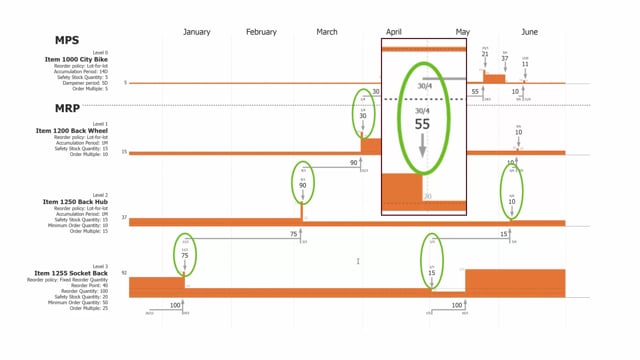
In Reverse Planning, we have added the field move order date to the item card.
And before I’ll explain how this works, I’ll just show you shortly in Business Central where it’s placed.
So, this is the item card for back wheel, and I’ve added the move order date three days here in the field on the item card.
So, this is where you set up a date formula for the move order date functionality.
Let’s see what it’s actually doing.
When we run MRP plan or Reverse Planning, we will create supplies based on demand.
So, if you look at item number 1,000 here in this example, we have some demands and when it start calculating, it will suggest supplies for this item.
And those dates, those supply will have a start date and an end date that applies to the next level when it calculates and break down the hierarchy here in level one, where it creates demands for those supplies in the top level that creates a new inventory profile, new demands on the lower level, et cetera.
This way it runs through all the hierarchy.
So, this is in close binding on the supply days and the demand dates, meaning normally you would have either the day before or the same day, depending on your setup, that the supply and the demand are linked.
This is an issue when trying to calculate back.
If you change one of your demands just one or two days back, you will have to reschedule your supply.
So, the problem is when it’s very close linked, that the rescheduling will be very sensitive and even though if you use the dampeners, the dampener only apply to one direction.
So, if the demand go back, the supply will have to go back as well.
Therefore, we have added functionality to add the move order due date functionality.
And this means when we start from the top level again, and before we have a due date like 1st of April and this scenario, it will move three days back.
So, the new date will be 29th of March, etc.
On the lower level, because we’re also on the back up, added the move order due date.
So, it applies to the component if it’s a production order, it applies to the component or sales line if it’s a sales order.
And the last level is the same because we didn’t add the move order date functionality.
This way we have gaps in the dates and it makes the functionality less sensitive.
So, it’s possible now to run the plan and then delay or postpone the order in the hierarchy.
So, it’s easier to move a little here and there without changing all the plan again and again.
And if you use this together with the standard dampeners in Business Central, you can make sure the MRP planning is not replanning all the orders all the time as sensitive.

